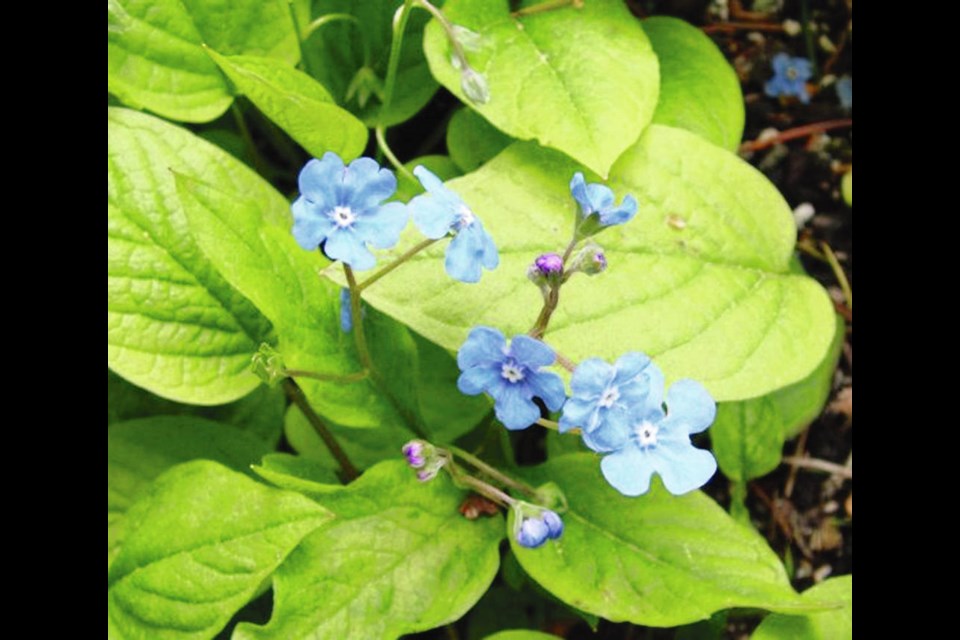In the garden, as in life, one thing often leads to another — and then another.
I could not have known, when a friend gave me a little plant to take home for my garden, that it would lead, years later, to a horticulture adventure that involved mystery, and confusion. When my friend passed me the plant, which she felt I should have in my garden, she identified it as an Omphalodes (om-fa-LO-deez).
I’d never heard of it. The name is taken from the Greek for navel, because the seeds resemble the shape of the human navel. Its common names are navel seed and navelwort. My plants are Omphalodes verna, the descriptive term indicating the bloom time, in spring.
I installed the little plant in a bed beside the carport, where it has spread nicely to form a low carpet of attractive heart-shaped leaves decorated in early spring with sprays of bright blue flowers for which the plant is known as creeping forget-me-not.
Because the planting has done so well, with little care and in less than cushy soil conditions, I decided two years ago to try growing another Omphalodes species, from seed.
The seeds I ordered from a British catalogue germinated vigorously and produced robust transplants that I settled into a small bed beside the garden shed, to serve as an underplanting for spireas and a tall Hypericum shrub.
This spring, in May, those seed-grown plants put on a lovely show of shiny, linear leaves and arching sprays of blue flowers — a nice followup to O. verna’s March blooms.
The mystery: I purchased the seeds as Omphalodes linifolia, a species with white flowers. The foliage is the right shape, but the flower colour is wrong for the species. Only one of the many references I consulted notes that linifolia’s flowers can be blue.
That means my plants could possibly be an O. linifolia oddity or, more likely, they are another species, quite possibly O. nitida, which has my plants’ narrow leaves and blue flowers in the same May bloom period.
Amidst the confusion, part of my mind wants to just relax and think about Shakespeare and the family feud in his play Romeo and Juliet: “What’s in a name? That which we call a rose/By any other name would smell as sweet.”
My sweet blue flowers will be as lovely under any name. Still, there are some among us who are addicted to solving puzzles placed before them.
Seed sources for Omphalodes are Chiltern Seeds (O. linifolia) and Plant World Seeds (nitida, linifolia). Any plants available locally in the spring are most likely to be named varieties of O. cappadocica (blue-eyed Mary). Heritage Perennials, a major wholesale supplier of perennials to local garden centres, list on their website (perennials.com) Cherry Ingram and Starry Eyes.
Cherry Ingram is a Royal Horticultural Society Award of Garden Merit winner. Its spring flowers turn, as they mature, from deep blue to violet. The plants are recommended as good companions for hostas and ferns. Starry Eyes has sky blue flowers with white-edged petals. The Heritage website suggests planting it with soft yellow daffodils.
With the new year’s catalogues about to begin arriving, consider venturing into the unknown. If a completely unfamiliar plant attracts your attention, and promises to do well in your garden, dare to try it.
Bee bulletin. Susan, who gardens in Langford, wrote with a helpful comment on a recommendation I made for an evergreen shrub or small tree to serve as a privacy screen by the front door of a home.
I suggested two possibilities: Mexican orange blossom (Choisya ternata) and California lilac (Ceanothus) — Choisya for its glossy, aromatic foliage and fragrant spring flowers, Ceanothus for its easy durability and extended season of blue flowers.
Regarding the Ceanothus, Susan said, “I would caution against that choice. Many years ago I decided never to plant a Ceanothus near a path, a seating area, or a doorway. The bees go mad for the flowers in spring and some people are allergic to their stings.”
It’s a useful caution to pass along, though I see Ceanothus plants used liberally in the municipal gardens near my home. Susan’s note did bring to mind the swarms of bees in and around my rhododendrons in spring. I edge my way by them with great care while they’re in bloom.



